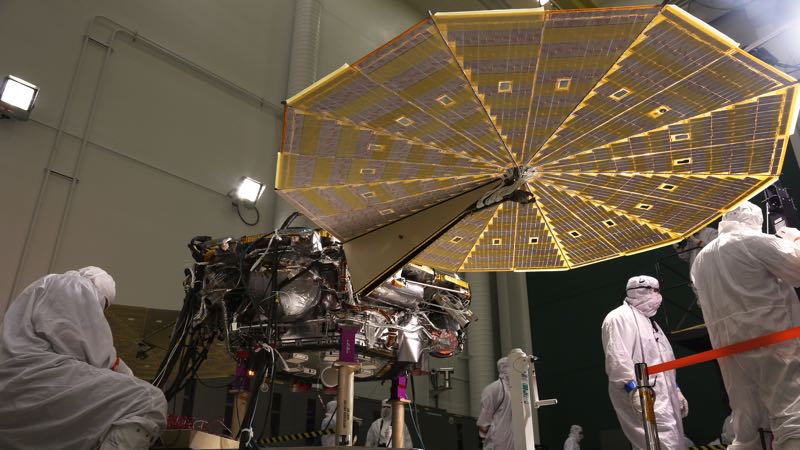NASA’s next Mars lander, InSight, has passed a critical test in preparation for its first mission to explore Mars' deep interior. The spacecraft extended the solar arrays that will power the InSight spacecraft once it lands on the Red Planet this November.
InSight – short for Interior Exploration using Seismic Investigations, Geodesy and Heat Transport – is scheduled to launch on 5 May 2018 from Vandenberg Air Force Base on a ULA Atlas V rocket. It will investigate processes that shaped the rocky planets of the inner solar system (including Earth) more than four billion years ago.
The solar wing test took place at a cleanroom operated by Lockheed Martin Space. The environment controlled facility is located just outside of Denver, where InSight was built and has been undergoing testing ahead of its launch. The mission is led by NASA's Jet Propulsion Laboratory in Pasadena, California.
"This is the last time we will see the spacecraft in landed configuration before it arrives a the Red Planet," said Scott Daniels, Manager at Lockheed Martin InSight Assembly, Test and Launch Operations (ATLO). He added: "There are still many steps we have to take before launch, but this is a critical milestone before shipping to Vandenberg Air Force Base in California." The InSight launch window opens in May.

Credit NASA Mars Insight Mission
The solar arrays on NASA's InSight Mars lander were deployed as part of testing conducted on 23 January 2018, at Lockheed Martin Space in Littleton, Colorado.
Engineers and technicians evaluated the solar arrays and performed an illumination test to confirm that the solar cells were collecting power.
The fan-like solar panels are specially designed for Mars' weak sunlight, caused by the planet's distance from the Sun and its dusty, thin atmosphere.
The panels will power InSight for at least one Martian year (two Earth years) for the first mission dedicated to studying Mars' deep interior.
"Think of InSight as Mars' first health check-up in more than 4.5 billion years," said Bruce Banerdt of JPL, the mission's principal investigator. "We'll study its pulse by 'listening' for marsquakes with a seismometer. We'll take its temperature with a heat probe. And we'll check its reflexes with a radio experiment."
Technicians at Lockheed Martin Space installed a microchip with 1.6 million names submitted by the public to ride along with NASA's InSight mission to Mars.
The microchip joins a chip containing almost 827,000 names that was glued to the top of InSight back in 2015, adding up to a total of about 2.4 million names going to Mars. "It's a fun way for the public to feel personally invested in the mission," Banerdt said. "We're happy to have them along for the ride."
The chips were inscribed at JPL's Microdevices Laboratory, which has added names and images to a number of spacecraft, including the Mars Spirit, Opportunity and Curiosity rovers.
Each character on the InSight microchips is just 400 nanometers wide. Compare that to a human hair, 100,000 nanometers wide, or a red blood cell, 8,000 nanometers wide.




